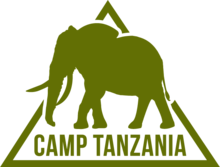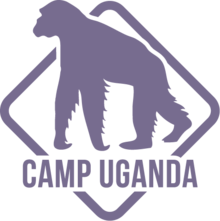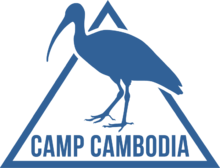Camps International
 | |
| Limited Company | |
| Industry | School expeditions and gap year trips |
| Founded | 2002 |
| Headquarters |
Ringwood, United Kingdom Dubai, United Arab Emirates Diani, Kenya Kota Kinabalu, Malaysia Quito, Ecuador |
Key people |
Stuart Rees Jones, CEO and Director Matt Lacey, COO and Director Simon Englefield, Director (Africa) Rory Hall, Director (Africa) Carl Palmer, Financial Director |
| Products | Gap year and school trips |
Number of employees | 150+ |
| Website |
www |
Camps International Ltd is an international volunteer travel operator headquartered in Ringwood, Hampshire UK and Dubai, UAE. Camps International build permanent volunteer accommodation camps within Kenya, Tanzania, Uganda, Malawi, Borneo, Cambodia, Ecuador and Peru. Its products include gap year volunteer trips, adventure expeditions and educational volunteer expeditions for UK and UAE school groups.
Camps International was founded in 2002 by Stuart Rees Jones, selling volunteer expeditions to Diani, Kenya, for volunteers to participate in projects related to the local school. In 2003, Stuart Rees Jones and Simon Englefield set up Camp Kenya Limited, as a branch of Camps International, to help manage the projects based in Diani. Camp Kenya offices are located on Diani Beach. The Camp Kenya headquarters are led by director Simon Englefield. In 2010 they were featured in The Telegraph Gap Year 100 Company Directory.[1]
Camps International now employ over 150 local people from the communities surrounding their camps .
Camp locations
Camp Kenya

Camp Kenya is branch of Camps International UK, UAE and Kenya based gap year sports and school expedition provider. The company was founded in 2003 by Stuart Rees Jones and Simon Englefield.
Camp Kenya Headquarters in Kenya are based in Diani, Ukunda 50 km south of Mombasa and also bordering Tsavo national parks, 160 km north west of Mombasa. The Camp Kenya logo features a black rhino which is classified as critically endangered in Kenya.
Camp Muhaka
Camp Muhaka is a permanent bush camp set within a small rural African community on the lower slopes of the Shimba Hills National Reserve. Built in 2007, the camp sits in the middle of a forest of palm and mango trees.
Camps International’s Camp Kenya branch project manages education initiatives for the area’s local schools, building homes for elderly residents and the poor.
Camp Tsavo

Camp Tsavo is a permanent camp located in Maungu, which is between Tsavo East and Tsavo West national parks near Voi. The camp was set up by Camps International’s Camp Kenya branch on 9 October 2014. Camp Kenya branch oversee and manage projects in the area for education initiatives and wildlife conservation initiatives. In 2015, Camp Tsavo was ‘Highly Commended’ in The Safari Awards for ‘Best Community Focused Safari Property’, ‘Best Ecologically Responsible Safari Property’.
Camp Tanzania
Following the growth of Camp Kenya, Camps International expanded into Tanzania and set up Camp Tanzania in 2007. Camp Tanzania is a second branch of Camps International’s, parallel to the company’s Camp Kenya. The Camp Tanzania logo features an African elephant.
Camp Mbokomu
Camp Mbokomu is a permanent camp located within a rural village on the foothills of Mt Kilimanjaro and was founded in 2007 by Camps International. Camp Mbokomu project manages environmental conservation work within the surrounding area.
Camp Kidia
Camp Kidia is a permanent camp located within a rural village on the foothills of Mount Kilimanjaro and was founded in 2007 by Camps International. Camp Kidia project manages environmental and wildlife conservation work within the area.
Camp Uganda

Camp Uganda was founded in 2012. Camp Uganda is a branch of Camps International. Camps International established itself in Uganda in partnership with the Ziwa Rhino Sanctuary. Ziwa Rhino Sanctuary is 60 km North of Uganda’s capital, Kampala, and Camp Uganda is based on an island at the source of the Nile River. The camp oversee and project manage wildlife conservation work. The Camp Uganda logo features an eastern chimpanzee which is native to Uganda.
Camp Borneo

Camp Borneo was founded on 21 August 2008 under the company Camps International. The branch was granted a license to operate as an inbound tour operator under the name of Camp Borneo Travel & Tours Sdn Bhd in March 2009. The company has its main offices in Kota Kinabalu, Sabah with three permanent camps in rural areas of the Malaysian state of Sabah. The Camp Borneo logo features an orangutan, selected because it is one of the most iconic animals native to Borneo. Many Camp Borneo volunteers visit Sepilok Orang Utan Rehabilitation Centre during their trip.
Camp Borneo works closely with PACOS Trust , a local grass roots charity, working to improve rural standards of living.
Camp Tinangol
Camp Borneo opened their first camp, Camp Tinangol, in 2009. The camp is 30 minutes south of the district town of Kudat, in northern Sabah. It is based on the outskirts of the Rungus ethnic group community, and is built around two large traditional style longhouses. The camp was opened following the consent of the local community and landowners. The camp managed the construction of a kindergarten facility which was officially opened on 30 January 2015, in conjunction with sustainable design firm Arkitrek .
Camp Mantanani
Camp Mantanani is located on Pulau Mantanani (Mantanani Island) off the north west coast of Sabah, and was established in late 2009 by Camps International, with the consent of landowners and community officials on the island. Situated along the beach from the main Baju Laut community, the camp consists of a number of open sided bunkhouses and is situated 10 metres from the shore. The camp managed the construction of a Community Learning Centre which was opened in late 2013, along with other on-going small community development projects.
Camp Bongkud
Camp Bongkud was opened by Camps International within the Dusun community of Kg Bongkud to the east of Ranua. The camp is nearby to the Poring Hot Springs and is situated within the main community. It is the largest of Camp Borneo’s permanent camps being able to house up to 100 visitors. Camp Bongkud oversaw the construction of the Asang Community Centre[2] which was opened in December 2014, and built by Camp Borneo volunteers. It was built using recycled driftwood collected during beach cleanups[3]
Other projects include the construction of small pedestrian bridges to aid during rainy season and refurbishment of both a single mothers’ centre and small kindergarten.
Camp Cambodia

Camps International (Cambodia) Co. Ltd was incorporated on 13 July 2010 as a licensed tour operator and has its main office in Siem Reap. The company runs two permanent camps in Cambodia located in Beng Pae and Beng Mealea. The Camp Cambodia logo features a giant ibis, a critically endangered ibis found in northern Cambodia.
Camp Beng Mealea
Camp Beng Mealea was established in 2010, taking its first visitors at the end of that year. Beng Mealea is located 90 mins northeast of Siem Reap town, and has its own temple complex. The camp contains three longhouses and can take up to 80 visitors in capacity. The camp project manages improvements to a local school’s infrastructure including the library, teacher accommodation block and classroom refurbishment.
Camp Beng Pae
Camp Beng Pae was established in May 2014 and is situated within Kampong Thom Province. It is approximately 50 km north of Kampong Thom town, sitting on the edge of the Beng Pae Wildlife Reserve within Tu Lek village. It contains two large longhouses for accommodation with a capacity of 64 people. The camp project manages a tree nursery, building houses for impoverished families and refurbishment within the community’s school.
Camp Ecuador

Camp Ecuador was founded in 2011 and founded by Latin America Director Damian Scott-Masson. The Camp Ecuador logo features an Andean condor, the national symbol of Ecuador.
Camp Maqui
Camp Maqui officially opened in February 2012 and is the main camp within Camps International’s Latin American branch. It is based in the cloud forest of the Ecuadorian Andes, two hours away from Quito. The camp is responsible for the management of projects such as the reconstruction of a nursery/community centre, which is used by the local residents for meetings and activities for children, as well as providing English lessons for the children in the local school. The camp is volunteers built a bridge over the river situated next to the community, with the goal of supporting local tourism, and constructing water tanks to help improve the quality of water that is distributed to the community.
Camp Amazonia
Camp Amazonia is located in a small Kichwa community, one hour away from the city of Tena. The camp includes a timber camp house built by the local community, and there is a river next to the camp. The camp was officially opened in October 2012. The camp is responsible for building a playground for the local children within the community in 2012. The camp also project manages the building of fish ponds, bus stops, community buildings including kitchens and dining halls for the community’s school. The camp also manage a reforestation project within a local botanical garden, helping to prevent the extinction of native Ecuadorian plants.
Camp Costa
Camp Costa is located on the “Ruta del Spondylus” that goes along the Ecuadorian Pacific Coast and is a half an hour drive from Puerto López, a fishing town. The camp houses a community building that is also used for tourists who visit the area. The camp is located on the shores of the Pacific Ocean. The camp are responsible for the project management of building a playground in the community, a fence around a school that is located near a busy highway, a birdwatching space, cleaning the beach, building and managing an organic farming greenhouse. Volunteers also built a giant turtle statue out of recycled materials that were found on beach cleaning projects. The turtle displays information on the importance of recycling and preserving the habitat of turtles in the area.
Camp Kuri Kucho
Camp Kuri Kucho was opened in July 2014. It is situated close to the Cayambe volcano, thirty minutes away from Cayambe town. The camp were responsible for the development of a cultural centre (known as a Pukara in Quichua) the construction of an organic agricultural farm and a playground for the children within the local community.
Camp Peru

Camp Peru was founded in August 2012, with the first volunteers travelling in 2014. The Camp Peru logo is a llama, an animal famously associated with Peru.
Camp Titicaca
Camp Titicaca was set up in July 2014. It is located on a small peninsula near the town of Capachica, on the shores of Lake Titicaca. It is situated between the cities of Juliaca and Puno. The camp has overseen the building of toilets and shower facilities, and providing running water and electricity to houses in the community. The camp have also managed providing English lessons to people within the community.
Camp Colca
Camp Colca was opened in July 2014, with its first group of volunteers being part of Camps International’s school expedition trips. It is located on the edge of the Colca Canyon and is in the middle of a small town on the road from Chivay to Cabanaconde. Arequipa is the nearest city, situated about three hours away. The camp are responsible for building a kitchen for the local primary school in February 2015, the refurbishment of classrooms in the secondary school and the relaying of the kindergarten’s playground. The camp also provide English lessons in the community and have developed the aesthetics of the community plaza.
Camp Moray
Camp Moray is due to open in June 2015, with its first group of volunteers due to be part of Camps International’s school expedition trips. Camp Moray is located around two hours from Cusco, near the ancient Inca Moray ruins. The camp sits high in the Sacred Valley. The camp will be responsible for projects to develop water systems, build toilets and greenhouses for the community, and reforest large areas of the land surrounding the community, due to start in June 2015.
The Camps Foundation
The Camps Foundation is a Registered Charity #1125858[4] founded by Camps International in 2009. All money raised for The Camps Foundation is spent on project work that is undertaken by volunteers on Camps International expeditions, because the company covers all administration and running costs of the charity.
Awards
Camps International have won a number of awards including:
- Safari Awards 2015 Finalist: Best Ecologically Responsible Safari (Camp Tsavo)[5]
- Safari Awards 2015 Finalist: Best Community Focused Safari Property (Camp Tsavo)[6]
- Safari Awards 2015 Finalist: Best Value Safari Property (Camp Tsavo)[7]
- Global Angels Awards 2013: Business With Exceptional DNA[8]
- British Youth Travel Awards 2012: Best Volunteering Organisation Finalist[9]
- Global Angels Awards 2012: Outstanding Social Enterprise[10]
- Eco Warrior Award Winner 2010: Most Sustainable Community Based Tourism Enterprise[11]
- Virgin Holidays Responsible Tourism Awards 2008: Best Volunteering Organisation Winner[12]
- Virgin Holidays Responsible Tourism Awards 2007: Best Volunteering Organisation Highly Commended[13]
Accreditations
Camps International are accredited by:
- Learning Outside the Classroom Quality Badge
- British Safety Standard BS8848[14]
- ASDAN[15]
- Duke of Edinburgh
- EPA Expedition Providers Association
References
- ↑ Frommer (20 August 2010). "Gap Year 100 Company Directory". The Telegraph. Retrieved 2010-08-20.
- ↑ Vanar, Muguntan (17 December 2014). "Pioneer British volunteer honoured". Daily Express. Retrieved 2014-12-14.
- ↑ Vanar, Muguntan (12 November 2012). "Natural work of architecture". The Star. Retrieved 2012-11-12.
- ↑ "Camps Foundation Charity Commission Registration". Camps Foundation Charity Commission Registration. Charity Commission. Retrieved 16 April 2015.
- ↑ "Safari Awards 2015 Finalist: Best Ecologically Responsible Safari (Camp Tsavo)". Safari Awards. Safari Awards. Retrieved 16 April 2015.
- ↑ "Safari Awards 2015 Finalist: Best Community Focused Safari Property (Camp Tsavo)". Safari Awards. Safari Awards. Retrieved 16 April 2015.
- ↑ "Safari Awards 2015 Finalist: Best Value Safari Property (Camp Tsavo)". Safari Awards. Safari Awards. Retrieved 16 April 2015.
- ↑ "Global Angels Awards 2013: Business With Exceptional DNA". Global Angel Awards. Global Angel Awards. Retrieved 15 November 2013.
- ↑ "British Youth Travel Awards: Best Volunteering Organisation Finalists". British Education Travel Association. British Education Travel Association. Retrieved 6 December 2012.
- ↑ "Global Angels Awards 2012: Outstanding Social Enterprise". Global Angel Awards. Global Angel Awards. Retrieved 9 November 2012.
- ↑ "Eco Warrior Award Winner 2010: Most Sustainable Community Based Tourism Enterprise". Eco Tourism Kenya. Eco Tourism Kenya. Retrieved 9 October 2014.
- ↑ "Virgin Holidays Responsible Tourism Awards 2008: Best Volunteering Organisation Winner". World Responsible Tourism Awards. World Responsible Tourism Awards. Retrieved 12 November 2008.
- ↑ "Virgin Holidays Responsible Tourism Awards 2007: Best Volunteering Organisation Highly Commended". World Responsible Tourism Awards. World Responsible Tourism Awards. Retrieved 12 November 2007.
- ↑ "BS 8848 Compliance Document: Version 2007 + A1: 2009" (PDF). Camps International. British Safety Standard BS8848. Retrieved 12 November 2007.
- ↑ "ASDAN". ASDAN. ASDAN.
External links
- Camps International Official Website
- Camps International UAE Website
- Camps International on Facebook
- Camps International on Instagram
- Camps International on Twitter
- Camps International on Pinterest